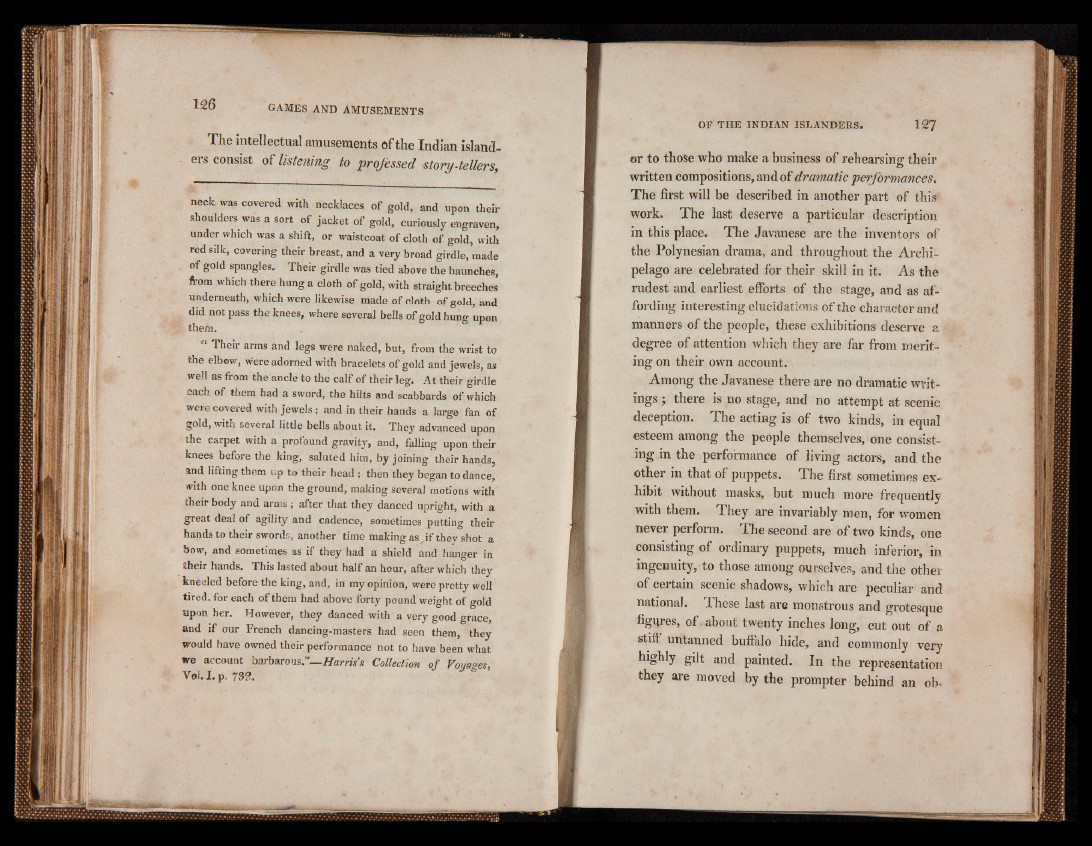
The intellectual amusements of the Indian island-
- ers consist of listening to 'professed story‘tellers,
neck was covered with necklaces of gold, and upon their
shoulders was a sort of jacket of gold, curiously engraven,
under which was a shift, or waistcoat of cloth of gold, with
red silk, covering their breast, and a very broad girdle, made
of gold spangles. Their girdle was tied above the haunches,
from which there hung a cloth of gold, with straight breeches
underneath, which were likewise made of cloth of gold, and
did not pass the knees, where several bells of gold hung upon
them.
Their arms and legs were naked, but, from the wrist to
the elbow, Were adorned with bracelets of gold and jewels, as
well as from the ancle to the calf of their leg. At their girdle
each of them had a sword, the hilts and scabbards of which
were covered with jewels; and in their hands a large fan of
gold, with several little bells about it. They advanced upon
the carpet with a profound gravity, and, falling upon their
knees before the king, saluted him, by joining their hands,
and lifting them up to their head ; then they began to dance,
with one knee upon the ground, making several motions with
their body and arms ; after that they danced upright, with a
great deal of agility and cadence, sometimes putting their
hands to their swords, another time making as J f thev shot a
bow, and sometimes as if they had a shield and hanger in
their hands. This lasted about half an hour, after which they
kneeled before the king, and, in my opinion, were pretty well
tired, for each of them had above forty pound weight of gold
upon her. However, they danced with a very good grace,
and if our French dancing-masters had seen them, they
would have owned their performance not to have been what
we account barbarous.”—Harris’s Collection o f Voyages,
Vol. I. p. 732.
er to those who make a business of rehearsing their
written compositions, and of dramatic performances.
The first will be described in another part of this
work. The last deserve a particular description
in this place. The Javanese are the inventors of
the Polynesian drama, and throughout the Archipelago
are celebrated for their skill in it. As the
rudest and earliest efforts of the stage, and as affording
interesting elucidations of the character and
manners of the people, these exhibitions deserve a
degree of attention which they are far from meriting
on their own account.
Among the Javanese there are no dramatic writings
; there is no stage, and no attempt at scenic
deception. The acting is of two kinds, in equal
esteem among the people themselves, one consisting
in the performance of living actors, and the
other in that of puppets. The first sometimes exhibit
without masks, but much more frequently
with them. They are invariably men, for women
never perform. The second are of two kinds, one
consisting of ordinary puppets, much inferior, in
ingenuity, to those among ourselves, and the other
of certain scenic shadows, which are peculiar and
national. These last are monstrous and grotesque
figures, of . about twenty inches long, cut out of a
stiff untanned buffalo hide, and commonly very
highly gilt and painted. In the representation
they are moved by the prompter behind an ob